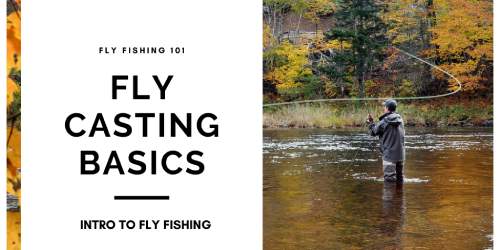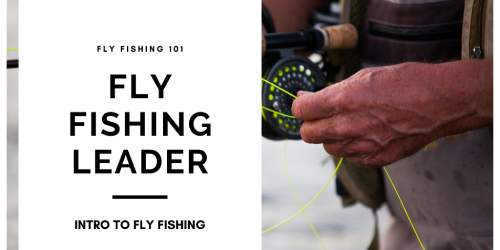How to Make a Fly Cast in 7 Easy Steps
6 Minutes reading time 📖 We do not use AI to create content; written by Anglers, for Anglers 🎣

In this article we will break down how to cast the fly rod and how to present the fly to the fish.
Finally, after hours of research on how to select a fly rod, reel, line, and spooled your line up. You’re excited to get out on the water and start catching fish on your new setup, but then you remember that you haven’t been taught how to make a fly cast.
If you need to learn about fishing flies, 👈 we have you covered.
The following section will talk a little about fly leaders. We will only briefly touch on the leader, because it makes a difference when learning how to cast a fly rod.
Fly Fishing Leader Size
Firstly; make sure that you have an appropriate leader for the type of fly you plan on casting. The right leader is the first part of the basics of fly casting.
The leader will also affect how you are able to present the fly – a leader that is too stiff will not allow you to present a supple dry fly in a delicate manner.
Conversely, a leader that is too light could potentially break off when you catch a large fish on a big streamer or top-water popper.
How to Hold Your Fly Rod When Casting
Before we break down the steps of executing a proper cast, make sure you are holding the rod correctly.
Your dominant hand should be on the handle, with your thumb on the top of the handle pointed straight.
To get a picture of this in your mind, imagine giving somebody a thumbs up 👍 but while you do it you have wrapped your fingers around the handle of the fly rod and are holding it straight up in the air.

It may feel a little awkward at first, but it’s important you have the proper grip in order to make accurate casts. Your pointer finger and middle finger of the hand you are holding the rod with are going to hold onto the fly line, so you have a solid connection with the line you have cast.
While you are holding the rod, stick those two fingers out, and using your non-dominant hand, grab the line near the first guide above the reel and lay it on those fingers you just stuck out.
Pull the two fingers back and wrap them around the rod’s handle. This is going to be what you do the majority of the time you are fishing, so get used to grabbing the line and securing it with your two fingers.
Now, you are ready to cast!
7 Steps to Casting a Fly Rod
The time has come to make your first fly fishing cast.
STEP 1: Pull out about 10 or 12 yards of line from your reel, dropping the line into the water as you pull it out. Eventually, you will be able to make longer casts but for now, staying around the 25-35 foot range will be a manageable distance for your first few trips, and will be less line to work with overall.
STEP 2: Hold onto the line that is near the closest guide to your reel with your non-dominant hand. You will not hold the line against the rod handle with your dominant hand when you are casting. Instead, all the line control will be done with your non-dominant hand.
STEP 3: Take your rod and cast it straight back. This should pick up the bit of line that’s out in front of your rod, along with the leader and the fly. When you do this, you should be holding onto the line with your non-dominant hand. You do not want to let any line slip through your hand at this point. We just want to get the line and leader that you have out airborne.
STEP 4: Once you’ve made the backcast, we are going to make a forward cast (side note: making a backcast and then a forward cast is called false casting). You are going to want to cast the rod forward, stopping it at about 10 o’clock if 12 is straight up and 6 is straight down and you are facing towards the 9. As you do this, loosen the grip on the line that you have with your non-dominant hand, allowing the line to slide freely through your fingers. Do not let go of the line completely.
STEP 5: Before the line lands on the water, grip the line again with your non-dominant hand so no line can flow through and cast the rod tip backward, stopping at about 2 o’clock. This should send the line you just let out and the leader with your fly back behind you.
STEP 6: Repeat this process of casting forward and releasing some line and then backcasting until you have enough line out to reach the cover you are trying to fish. When you want to actually present the fly and don’t want to cast anymore, you will make one final forward cast, but not release the line quite as much as you normally do. Instead, maintain a bit more control of it, and bring your rod tip down almost to the water as the fly lands. This will help the fly land softly.
STEP 7: Bring the line back to the two fingers of your hand that is holding the rod and pinch it against the handle. You now have made a cast with your fly rod!
How to Make a Fly Cast 🏁 Final Thoughts
Hopefully, you found this article somewhat informative and helpful.
Fly casting can be very tricky to learn, so don’t get discouraged if you aren’t getting it right away.
Take some time and practice on the water, you should be able to make a pretty good cast after a few hours!
If you are struggling, just remember that a bad day of fishing (or learning to cast a fly rod) is better than a good day at the office!
Until next time – good luck, and tight lines!




